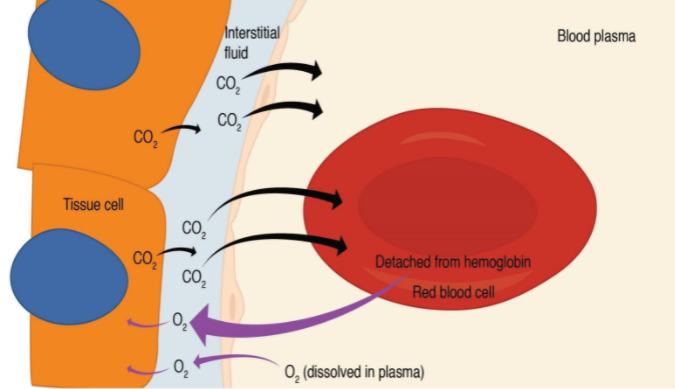
What happens in internal respiration?
Answer
411k+ views
2 likes
Hint: Respiration is the process of taking in oxygen and giving out of carbon dioxide. The oxygen is used to oxidise glucose so as to liberate energy in the form of ATP. Respiration is of two types external and internal. In internal respiration, the gaseous exchange occurs between the blood and the cells.
Complete answer:
The main organ of respiration in our body is the lungs. We breathe in oxygen and give out carbon dioxide. The gaseous exchange takes place at the alveoli where oxygen and carbon dioxide are exchanged between the alveoli and the blood. This is known as external respiration. The gaseous exchange further takes place between the blood and the cells. This is termed internal respiration.
Let us discuss in detail internal respiration-
The gaseous exchange mainly occurs through diffusion. The carbon dioxide is given out as waste and oxygen are taken in. In internal respiration, the oxygen from the blood diffuses to the cells of the body. The oxygen is transported by the haemoglobin present in the blood. It is further transported to various cells through the blood stream.
The diffusion takes place between the bloodstream and the cells. Once the oxygen reaches every cell, the glucose is metabolised by the process of glycolysis in the cytoplasm and further, the release of energy takes place in mitochondria. The energy released is utilised by the cells to carry out other metabolic activities.
The diffusion of gases is shown in the figure below.

Note: The respiration which takes place in the presence of oxygen is known as aerobic respiration. In certain cases, like during strenuous exercise, due to lack of oxygen, the muscles respire anaerobically and forms lactate. This lactate is deposited in the muscles is the main reason cause fatigue.
Complete answer:
The main organ of respiration in our body is the lungs. We breathe in oxygen and give out carbon dioxide. The gaseous exchange takes place at the alveoli where oxygen and carbon dioxide are exchanged between the alveoli and the blood. This is known as external respiration. The gaseous exchange further takes place between the blood and the cells. This is termed internal respiration.
Let us discuss in detail internal respiration-
The gaseous exchange mainly occurs through diffusion. The carbon dioxide is given out as waste and oxygen are taken in. In internal respiration, the oxygen from the blood diffuses to the cells of the body. The oxygen is transported by the haemoglobin present in the blood. It is further transported to various cells through the blood stream.
The diffusion takes place between the bloodstream and the cells. Once the oxygen reaches every cell, the glucose is metabolised by the process of glycolysis in the cytoplasm and further, the release of energy takes place in mitochondria. The energy released is utilised by the cells to carry out other metabolic activities.
The diffusion of gases is shown in the figure below.

Note: The respiration which takes place in the presence of oxygen is known as aerobic respiration. In certain cases, like during strenuous exercise, due to lack of oxygen, the muscles respire anaerobically and forms lactate. This lactate is deposited in the muscles is the main reason cause fatigue.
Recently Updated Pages
Express the following as a fraction and simplify a class 7 maths CBSE

The length and width of a rectangle are in ratio of class 7 maths CBSE

The ratio of the income to the expenditure of a family class 7 maths CBSE

How do you write 025 million in scientific notatio class 7 maths CBSE

How do you convert 295 meters per second to kilometers class 7 maths CBSE

Write the following in Roman numerals 25819 class 7 maths CBSE

Trending doubts
State and prove Bernoullis theorem class 11 physics CBSE

What are Quantum numbers Explain the quantum number class 11 chemistry CBSE

Write the differences between monocot plants and dicot class 11 biology CBSE

1 ton equals to A 100 kg B 1000 kg C 10 kg D 10000 class 11 physics CBSE

State the laws of reflection of light

In northern hemisphere 21st March is called as A Vernal class 11 social science CBSE




